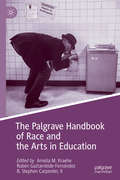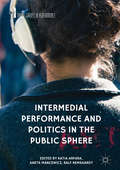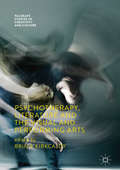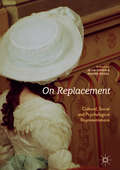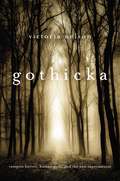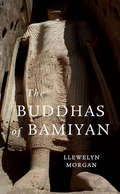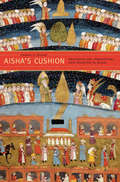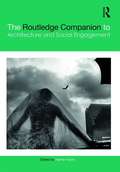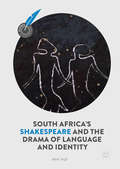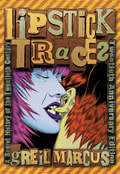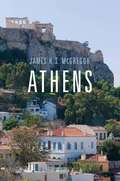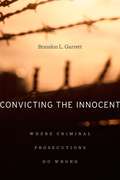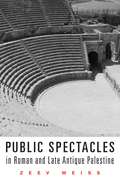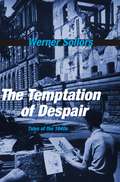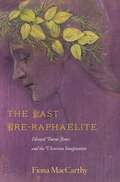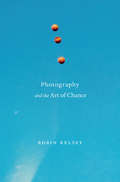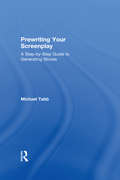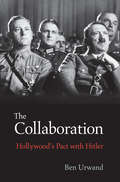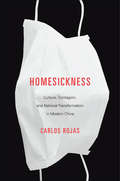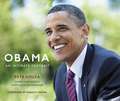- Table View
- List View
The Palgrave Handbook of Race and the Arts in Education
by Amelia M. Kraehe Rubén Gaztambide-Fernández B. Stephen Carpenter IIThe Palgrave Handbook of Race and the Arts in Education is the first edited volume to examine how race operates in and through the arts in education. Until now, no single source has brought together such an expansive and interdisciplinary collection in exploration of the ways in which music, visual art, theater, dance, and popular culture intertwine with racist ideologies and race-making. Drawing on Critical Race Theory, contributing authors bring an international perspective to questions of racism and anti-racist interventions in the arts in education. The book’s introduction provides a guiding framework for understanding the arts as white property in schools, museums, and informal education spaces. Each section is organized thematically around historical, discursive, empirical, and personal dimensions of the arts in education. This handbook is essential reading for students, educators, artists, and researchers across the fields of visual and performing arts education, educational foundations, multicultural education, and curriculum and instruction.
Intermedial Performance and Politics in the Public Sphere (Avant-Gardes in Performance)
by Katia Arfara Aneta Mancewicz Ralf RemshardtThis volume is a collection of scholarly articles and interviews with intermedial artists working with the concepts of public sphere at the intersection of aesthetics and politics. It explores the response of socially-engaged artistic practices to the current crisis in politics and media. It also critically examines urgent issues such as rampant nationalism and populism, expanding neoliberalism, the refugee crisis, growing inosculations of corporate and cyber culture, and the ongoing geopolitical changes in the Middle East. Can intermedial performances reflect the present artistic and political dilemmas in Europe and beyond?The collection provides theoretical frameworks that interrogate the role that spectators as citizens can play in our mediatized world while focusing on the functions of immersion, participation, and civic engagement in contemporary performance and society. The collection provides analyses by international scholars from Europe, Asia, and the USA, covering global performance created in the twenty-first century. It also introduces interviews with internationally acclaimed intermedial artists and companies such as BERLIN, Rimini Protokoll, Dries Verhoeven, Akira Takayama, and Kris Verdonck.
Intermedial Performance and Politics in the Public Sphere (Avant-Gardes in Performance)
by Katia Arfara Aneta Mancewicz Ralf RemshardtThis volume is a collection of scholarly articles and interviews with intermedial artists working with the concepts of public sphere at the intersection of aesthetics and politics. It explores the response of socially-engaged artistic practices to the current crisis in politics and media. It also critically examines urgent issues such as rampant nationalism and populism, expanding neoliberalism, the refugee crisis, growing inosculations of corporate and cyber culture, and the ongoing geopolitical changes in the Middle East. Can intermedial performances reflect the present artistic and political dilemmas in Europe and beyond?The collection provides theoretical frameworks that interrogate the role that spectators as citizens can play in our mediatized world while focusing on the functions of immersion, participation, and civic engagement in contemporary performance and society. The collection provides analyses by international scholars from Europe, Asia, and the USA, covering global performance created in the twenty-first century. It also introduces interviews with internationally acclaimed intermedial artists and companies such as BERLIN, Rimini Protokoll, Dries Verhoeven, Akira Takayama, and Kris Verdonck.
Psychotherapy, Literature and the Visual and Performing Arts (Palgrave Studies in Creativity and Culture)
by Bruce KirkcaldyThis book explores the relevance of literature and the performing and visual arts for effective clinical psychotherapy. There is a growing interest in the use of the arts in psychotherapy, in part due to an increasing awareness of the limitations in verbal communication and scepticism towards traditional forms of medical treatment. Gathering together perspectives from international practitioners this volume embraces the value of a range of mediums to psychotherapy, from film and photo-therapy to literature and narrative therapy. Based on theoretical studies, clinical expertise and experiential learning, authors offer detailed guidelines on the value of various art forms in practice.
Psychotherapy, Literature and the Visual and Performing Arts (Palgrave Studies in Creativity and Culture)
by Bruce KirkcaldyThis book explores the relevance of literature and the performing and visual arts for effective clinical psychotherapy. There is a growing interest in the use of the arts in psychotherapy, in part due to an increasing awareness of the limitations in verbal communication and scepticism towards traditional forms of medical treatment. Gathering together perspectives from international practitioners this volume embraces the value of a range of mediums to psychotherapy, from film and photo-therapy to literature and narrative therapy. Based on theoretical studies, clinical expertise and experiential learning, authors offer detailed guidelines on the value of various art forms in practice.
On Replacement: Cultural, Social and Psychological Representations
by Jean Owen Naomi SegalThis book is an interdisciplinary study of the human drama of replacement. Is one’s irreplaceability dependent on surrounding oneself by a replication of others? Is love intrinsically repetitious or built on a fantasy of uniqueness? The sense that a person’s value is blotted out if someone takes their place can be seen in the serial monogamy of our age and in the lives of ‘replacement children’ – children born into a family that has recently lost a child, whom they may even be named after. The book investigates various forms of replacement, including AI and doubling, incest and bedtricks, imposters and revenants, human rights and ‘surrogacy’, and intertextuality and adaptation. The authors highlight the emotions of betrayal, jealousy and desire both within and across generations. On Replacement consists of 24 essays divided into seven sections: What is replacement?, Law & society, Wayward women, Lost children, Replacement films, The Holocaust and Psychoanalysis. The book will appeal to anyone engaged in reading cultural and social representations of replacement.
On Replacement: Cultural, Social and Psychological Representations
by Jean Owen Naomi SegalThis book is an interdisciplinary study of the human drama of replacement. Is one’s irreplaceability dependent on surrounding oneself by a replication of others? Is love intrinsically repetitious or built on a fantasy of uniqueness? The sense that a person’s value is blotted out if someone takes their place can be seen in the serial monogamy of our age and in the lives of ‘replacement children’ – children born into a family that has recently lost a child, whom they may even be named after. The book investigates various forms of replacement, including AI and doubling, incest and bedtricks, imposters and revenants, human rights and ‘surrogacy’, and intertextuality and adaptation. The authors highlight the emotions of betrayal, jealousy and desire both within and across generations. On Replacement consists of 24 essays divided into seven sections: What is replacement?, Law & society, Wayward women, Lost children, Replacement films, The Holocaust and Psychoanalysis. The book will appeal to anyone engaged in reading cultural and social representations of replacement.
Gothicka: Vampire Heroes, Human Gods, And The New Supernatural
by Victoria NelsonThe Gothic has taken a revolutionary turn in this century. Today’s Gothic has fashioned its monsters and devils into heroes and angels and is actively reviving supernaturalism in popular culture. Nelson argues that this mainstreaming of a spiritually driven supernaturalism is a harbinger of what a post-Christian religion in America might look like.
The Buddhas of Bamiyan (Wonders of the world #16)
by Llewelyn MorganFor 1,400 years, two colossal Buddhas overlooked the Bamiyan Valley on the Silk Road in Afghanistan. The Buddhas embodied the intersection of East and West, and their destruction by the Taliban in 2001 provoked international outrage. Morgan excavates the layers of meaning these vanished wonders hold for a fractured Afghanistan.
Aisha’s Cushion: Religious Art, Perception, And Practice In Islam
by Jamal J. EliasWesterners have a strong impression that Islam does not allow religious imagery. Elias corrects this view. Unearthing shades of meaning in Islamic thought throughout history, he argues that Islamic perspectives on representation and perception should be sought in diverse areas such as optics, alchemy, dreaming, vehicle decoration, Sufi metaphysics.
The Routledge Companion Of Architecture And Social Enagagement
by Farhan Karim Farhana FerdousSocially engaged architecture is a broad and emerging architectural genre that promises to redefine architecture from a market-driven profession to a mix of social business, altruism, and activism that intends to eradicate poverty, resolve social exclusion, and construct an egalitarian global society. The Routledge Companion to Architecture and Social Engagement offers a critical enquiry of socially engaged architecture’s current context characterized by socio-economic inequity, climate change, war, increasing global poverty, microfinance, the evolving notion of professionalism, the changing conception of public, and finally the growing academic interest in re-visioning the social role of architecture. Organized around case studies from the United States, Brazil, Venezuela, the United Kingdom, South Africa, Rwanda, Burkina Faso, Nigeria, Nepal, Pakistan, Iran, Thailand, Germany, Australia, Taiwan, and Japan the book documents the most important recent developments in the field. By examining diverse working methods and philosophies of socially engaged architecture, the handbook shows how socially engaged architecture is entangled in the global politics of poverty, reconstruction of the public sphere, changing role of the state, charity, and neoliberal urbanism. The book presents debates around the issue of whether architecture actually empowers the participators and alleviates socio-economic exclusion or if it instead indirectly sustains an exploitive capitalism. Bringing together a range of theories and case studies, this companion offers a platform to facilitate future lines of inquiry in education, research, and practice.
The Routledge Companion of Architecture and Social Engagement (PDF)
by Farhan Karim Farhana FerdousSocially engaged architecture is a broad and emerging architectural genre that promises to redefine architecture from a market-driven profession to a mix of social business, altruism, and activism that intends to eradicate poverty, resolve social exclusion, and construct an egalitarian global society. The Routledge Companion to Architecture and Social Engagement offers a critical enquiry of socially engaged architecture’s current context characterized by socio-economic inequity, climate change, war, increasing global poverty, microfinance, the evolving notion of professionalism, the changing conception of public, and finally the growing academic interest in re-visioning the social role of architecture. Organized around case studies from the United States, Brazil, Venezuela, the United Kingdom, South Africa, Rwanda, Burkina Faso, Nigeria, Nepal, Pakistan, Iran, Thailand, Germany, Australia, Taiwan, and Japan the book documents the most important recent developments in the field. By examining diverse working methods and philosophies of socially engaged architecture, the handbook shows how socially engaged architecture is entangled in the global politics of poverty, reconstruction of the public sphere, changing role of the state, charity, and neoliberal urbanism. The book presents debates around the issue of whether architecture actually empowers the participators and alleviates socio-economic exclusion or if it instead indirectly sustains an exploitive capitalism. Bringing together a range of theories and case studies, this companion offers a platform to facilitate future lines of inquiry in education, research, and practice.
South Africa's Shakespeare and the Drama of Language and Identity (Global Shakespeares)
by Adele SeeffThis volume considers the linguistic complexities associated with Shakespeare’s presence in South Africa from 1801 to early twentieth-first century televisual updatings of the texts as a means of exploring individual and collective forms of identity. A case study approach demonstrates how Shakespeare’s texts are available for ideologically driven linguistic programs. Seeff introduces the African Theatre, Cape Town, in 1801, multilingual site of the first recorded performance of a Shakespeare play in Southern Africa where rival, amateur theatrical groups performed in turn, in English, Dutch, German, and French. Chapter 3 offers three vectors of a broadening Shakespeare diaspora in English, Afrikaans, and Setswana in the second half of the nineteenth century. Chapter 4 analyses André Brink’s Kinkels innie Kabel, a transposition of Shakespeare’s The Comedy of Errors into Kaaps, as a radical critique of apartheid’s obsession with linguistic and ethnic purity. Chapter 5 investigates John Kani’s performance of Othello as a Xhosa warrior chief with access to the ancient tradition of Xhosa storytellers. Shakespeare in Mzansi, a televisual miniseries uses black actors, vernacular languages, and local settings to Africanize Macbeth and reclaim a cross-cultural, multilingualism. An Afterword assesses the future of Shakespeare in a post-rainbow, decolonizing South Africa. Global Sha Any reader interested in Shakespeare Studies, global Shakespeare, Shakespeare in performance, Shakespeare and appropriation, Shakespeare and language, Literacy Studies, race, and South African cultural history will be drawn to this book.
South Africa's Shakespeare and the Drama of Language and Identity (Global Shakespeares)
by Adele SeeffThis volume considers the linguistic complexities associated with Shakespeare’s presence in South Africa from 1801 to early twentieth-first century televisual updatings of the texts as a means of exploring individual and collective forms of identity. A case study approach demonstrates how Shakespeare’s texts are available for ideologically driven linguistic programs. Seeff introduces the African Theatre, Cape Town, in 1801, multilingual site of the first recorded performance of a Shakespeare play in Southern Africa where rival, amateur theatrical groups performed in turn, in English, Dutch, German, and French. Chapter 3 offers three vectors of a broadening Shakespeare diaspora in English, Afrikaans, and Setswana in the second half of the nineteenth century. Chapter 4 analyses André Brink’s Kinkels innie Kabel, a transposition of Shakespeare’s The Comedy of Errors into Kaaps, as a radical critique of apartheid’s obsession with linguistic and ethnic purity. Chapter 5 investigates John Kani’s performance of Othello as a Xhosa warrior chief with access to the ancient tradition of Xhosa storytellers. Shakespeare in Mzansi, a televisual miniseries uses black actors, vernacular languages, and local settings to Africanize Macbeth and reclaim a cross-cultural, multilingualism. An Afterword assesses the future of Shakespeare in a post-rainbow, decolonizing South Africa. Global Sha Any reader interested in Shakespeare Studies, global Shakespeare, Shakespeare in performance, Shakespeare and appropriation, Shakespeare and language, Literacy Studies, race, and South African cultural history will be drawn to this book.
Lipstick Traces: A Secret History Of The Twentieth Century
by Greil MarcusThis is a secret history of modern times, told by way of what conventional history tries to exclude. Lipstick Traces tells a story as disruptive and compelling as the century itself.
Athens
by James H. McGregorRevered as the birthplace of democracy, Athens is much more than an open-air museum filled with crumbling monuments to ancient glory. Athens takes readers on a journey from the classical city-state to today's contemporary capital, revealing a world-famous metropolis that has been resurrected and redefined time and again.
Convicting the Innocent: Where Criminal Prosecutions Go Wrong
by Brandon GarrettDNA exonerations have shattered confidence in the criminal justice system by exposing how often we have convicted the innocent and let the guilty walk free. In this unsettling analysis, Garrett examines what went wrong in the cases of the first 250 people exonerated by DNA testing, and proposes systemic reforms.
Public Spectacles in Roman and Late Antique Palestine (Revealing Antiquity Ser. #21)
by Zeev WeissWishing to ingratiate himself with Rome, Herod the Great built theaters, amphitheaters, and hippodromes to bring pagan entertainments of all sorts to Palestine. Zeev Weiss explores how the indigenous Jewish and Christian populations responded, as both spectators and performers, to these cultural imports, which left a lasting imprint on the region.
The Temptation of Despair: Tales Of The 1940s
by Werner SollorsIn Germany the end of World War II calls forth images of obliterated cities, hungry refugees, and ghostly monuments to Nazi crimes. Drawing on diaries, photographs, essays, reports, fiction and film, Werner Sollors makes visceral the sorrow and anger, guilt and pride, despondency and resilience of a defeated people--and the paradoxes of occupation.
The Last Pre-Raphaelite: Edward Burne-Jones and the Victorian Imagination
by Fiona MacCarthyIn Fiona MacCarthy’s riveting account, Burne-Jones’s exchange of faith for art places him at the intersection of the nineteenth century and the Modern, as he leads us forward from Victorian mores and attitudes to the psychological, sexual, and artistic audacity that would characterize the early twentieth century.
Photography and the Art of Chance
by Robin KelseyAs anyone who has wielded a camera knows, photography has a unique relationship to chance. It also represents a struggle to reconcile aesthetic aspiration with a mechanical process. Robin Kelsey reveals how daring innovators expanded the aesthetic limits of photography in order to create art for a modern world.
Prewriting Your Screenplay: A Step-by-Step Guide to Generating Stories
by Michael TabbPrewriting Your Screenplay cements all the bricks of a story’s foundations together and forms a single, organic story-growing technique, starting with a blank slate. It shows writers how to design each element so that they perfectly interlock together like pieces of a puzzle, creating a stronger story foundation that does not leave gaps and holes for readers to find. This construction process is performed one piece at a time, one character at a time, building and incorporating each element into the whole. The book provides a clear-cut set of lessons that teaches how to construct that story base around concepts as individual as the writer’s personal opinions, helping to foster an individual writer’s voice. It also features end-of-chapter exercises that offer step-by-step guidance in applying each lesson, providing screenwriters with a concrete approach to building a strong foundation for a screenplay. This is the quintessential book for all writers taking their first steps towards developing a screenplay from nothing, getting them over that first monumental hump, resulting in a well-formulated story concept that is cohesive and professional.
The Collaboration: Hollywood's Pact With Hitler
by Ben UrwandTo continue doing business in Germany, Hollywood studios agreed not to make films attacking Nazis or condemning persecution of Jews. Ben Urwand reveals this collaboration and the cast of characters it drew in, ranging from Goebbels to Louis B. Mayer. At the center was Hitler himself--obsessed with movies and their power to shape public opinion.
Homesickness: Culture, Contagion, And National Transformation In Modern China
by Carlos RojasCarlos Rojas focuses on the trope of “homesickness” in China—discomfort caused not by a longing for home but by excessive proximity to it. This inverse homesickness marks a process of movement away from the home, conceived of as spaces associated with the nation, family, and individual body, and gives rise to the possibility of long-term health.
Obama: The Historic Presidency in Photographs
by Pete SouzaThe definitive visual biography of Barack Obama's historic presidency, captured in unprecedented detail by his Chief White House photographer, presented in an oversize, 12"x10"exquisitely produced format, and featuring a foreword from the President himself.Pete Souza was with President Obama during more crucial moments than anyone else and he photographed them all - from the highly classified to the disarmingly candid. Obama: An Intimate Portrait reproduces more than three hundred of Souza's most iconic photographs in exquisite detail, some of which have never been published before. Souza's photographs, with the behind-the-scenes captions and stories that accompany them, document the most consequential hours of the Presidency alongside unguarded moments with the President's family, his encounters with children, interactions with world leaders and cultural figures, and more. These images communicate the pace and power of America's highest office and reveal the spirit of the extraordinary man who became President. The result is a portrait of exceptional intimacy and a stunning record of a landmark era in American history.'Precious historical documents . . . vividly human and often funny . . . these images tell the true story of a presidency that words have failed' Jonathan Jones, Guardian
